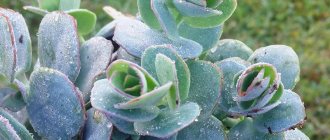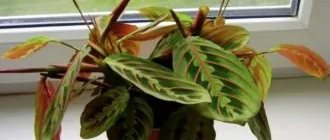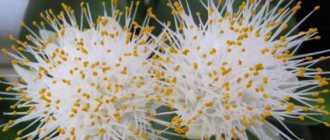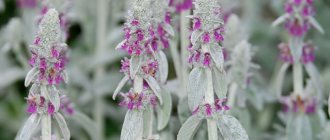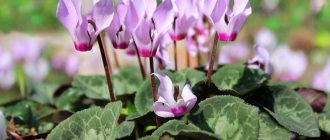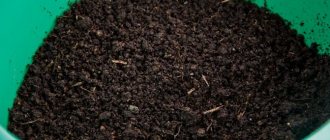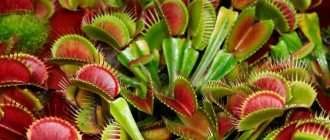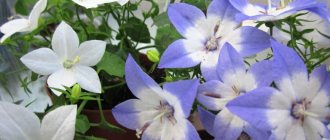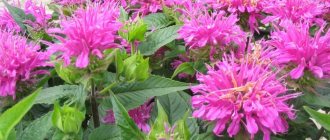Varieties used
Scientists know more than 200 species of Kalanchoe . Most plants have only decorative value; flowering varieties do not have medicinal properties. Medicinal types:
- Cirrus;
- Degremona.
They contain a lot of organic acids, microelements, and vitamins. The beneficial properties of the plant are used not only in folk healing practices.
Kalanchoe is included in many ointments, creams, and tinctures. Doctors often use the medicinal properties of Kalanchoe to treat a wide variety of diseases.
What does it help with?
The plant is used to treat a number of diseases. It is recommended to use the plant for the treatment of the following pathologies:
- skin diseases: wounds, abrasions, burns, frostbite, polyps - polyposis, warts, ulcers, bedsores, trophic ulcers;
- oral diseases: stomatitis, bleeding gums, gingivitis, toothache and sore throat;
- colds: acute respiratory viral infections, acute respiratory infections, runny nose, cough, otitis media, rhinitis, sinusitis;
- joint diseases;
- blurred vision;
- varicose veins or varicose veins;
- hemorrhoids;
- gastrointestinal pathologies: peptic ulcer, stomach and intestinal disorders.
The plant can also be used in cosmetology to improve the condition of skin and hair.
Appearance
Cirrus in its natural habitat reaches quite large sizes: up to 1 meter in height. At home, the plant is smaller, however, no less beautiful and can bloom profusely already in the second year of life.
The Cirrus has a soft, upward-pointing stem surrounded by leaves growing oppositely. The leaves are fleshy, oval-shaped, pinnately dissected at the ends. The medicinal plant blooms with pale pink or white inflorescences.
Degremon's leaves have an ovoid, very elongated shape. Sometimes the halves of the sheet are even folded along the midline. The leaves are quite long; in nature they grow up to 20 cm.
The plant is gray-green in color, with purple spots on the lower part of the leaves.
Photo
Kalanchoe diseases and treatment methods
The most common problem with Kalanchoe is considered to be fungus. It appears from excess moisture. This is facilitated not only by the water used for irrigation, but also by the moisture in the air. High humidity is not desirable in the rooms where such a flower is located.
The fungus attacks the root system and then reaches the stems. Gradually the plant dies. The foliage becomes faded, turns yellow, and subsequently falls off. It is practically impossible to restore rotten roots. To cope with the putrefactive process, the plant is transplanted into another container with disinfected soil (you can use a weak solution of potassium permanganate). How to replant Kalanchoe in this case? During replanting, root shoots that are damaged by rot are removed.
A plant can die not only if it is not properly cared for, but also if it is attacked by insects. There are several pests:
- scale insect;
- aphid;
- mealy worm.
The most common type of insect parasitizing Kalanchoe is the scale insect. When examining the affected plant, you can see characteristic spots of gray or light brown color. After some time, a fungus appears in their places. To prevent this from happening, the stain is carefully cleaned from the leaves, and then treated with an alcohol solution.
Plant characteristics
For medicinal purposes, the above-ground part of the plant is used: the stem and leaves.
More than 90% of the total mass of the plant is juice .
Compound:
- organic acids;
- vitamins C and P, as well as many others;
- flavonoids;
- tannins;
- mineral salts;
- micro- and macroelements;
- polysaccharides.
Medicinal (healing) properties of the flower.
Cleans wounds from pathogens, slows down their growth and reproduction.- Reduces inflammatory processes.
- Stops bleeding.
- Cleanses affected skin areas of dead tissue.
- Quickly restores the upper layers of skin after damage.
With all its advantages, Kalanchoe is also slightly toxic and does not cause irritation to the mucous membranes.
Recipes
Alternative medicine knows many recipes for cooking from Kalanchoe. The plant can be consumed fresh, but can also be used to make medicinal products in the form of juice, tinctures and infusions.
Juicing
For preparation, it is recommended to first place the collected leaves in the refrigerator for one week to soften. This makes it easier to extract juice from plant materials.
After the leaves have become softer, they should be crushed in any convenient way: crush in a mortar, grind in a meat grinder. The juice is squeezed out from the resulting mixture using gauze. Store the finished product in the refrigerator for no more than 2 weeks. Therefore, it is not recommended to prepare the mixture in large quantities.
For long-term storage, the juice is mixed with medical alcohol:
- 1 part – alcohol;
- 5 parts – juice.
In this form, the juice can be stored for about a year without losing its beneficial properties. To maintain immunity and treat diseases of the gastrointestinal tract, it is recommended to take 1 tsp. product, during meals, three times a day. You can add honey to improve the taste. The course of treatment is 2 weeks, then you should take a break for the same period.
Vodka tincture
The use of Kalanchoe tincture with vodka has contraindications due to its alcohol content. However, it is one of the effective remedies recommended for treating acne and treating wounds. When treating wounds or ulcers, the product is applied to the affected area using a cotton swab.
Folk uses
Most of the beneficial properties of the plant were initially noticed not by doctors at all, but by ordinary people who grew Kalanchoe (a surgeon without a knife), and they used it as a medicine.
For treatment at home, fresh juice is used: it is extracted from the fleshy leaves of the plant and trunk.
When Kalanchoe is processed for medicinal purposes, it retains many beneficial properties, and the prepared medicines are stored for a long time.
Alcohol tinctures are made from the leaves of the plant.
Ointments are prepared mainly from juice.
Crushed leaves help in removing warts.
People believe that a few eaten leaves can completely restore strength and restore good spirits.
Kalanchoe helps cope with stress and seasonal depression.
Treatment
The health benefits are undeniable. are treated with its help . What exactly does Kalanchoe treat and how to use it:
Gargling with juice diluted in water helps with sore throat and tonsillitis. It also helps perfectly in the treatment of sore throat.- Lotions made from the pulp of the plant help heal purulent wounds, leg ulcers and burns faster.
- Regular consumption of juice treats gastritis and stomach ulcers, reduces pain.
- Application will help with inflammation of the eyes (conjunctivitis and blepharitis) and are treated by instilling Kalanchoe juice.
- Tampons soaked in the juice of the plant reduce erosion and promote the healing of ruptures suffered by a woman during childbirth.
- The effect of the juice reduces inflammation in the urinary system.
- Regular instillation of plant juice into the nose helps cure both a common runny nose and sinusitis.
- The juice is used to treat inflammation of the ears.
- By regularly wiping your face with juice, acne disappears, skin oiliness decreases, and pores become smaller.
Contraindications
Kalanchoe also has contraindications.
Kalanchoe can harm the body only when self-medicated.
Very often people make mistakes in determining the diagnosis and may mistake allergies for ordinary acne.
In this case, drinking juice can only worsen the allergy.
In children , when the juice is instilled into the eyes or nose, the mucous membranes may become inflamed .
Consumption along with dairy products can lead to severe upset.
People who have cirrhosis of the liver, hepatitis, diabetes mellitus, glomerulonephritis, rheumatism, and low blood pressure should weigh the balance of risk and health benefits especially carefully. Should not be used for malignant tumors.
Doctors do not recommend using medications containing Kalanchoe during pregnancy.
Kalanchoe has been widely used in folk medicine for centuries. However, it is worth understanding that Kalanchoe not only has medicinal properties, but also has contraindications. Therefore, any treatment should be carried out only after consultation with a doctor.
Basic requirements for growing Kalanchoe
- As the indoor flower grows, it is periodically transplanted into a large container. A drainage made of sand and expanded clay is placed at the bottom of the pot. A newly planted plant should be in a well-lit room. This could be a window sill or a loggia.
- Watering is carried out only as the top layer of soil dries. The main condition is not to pour too much water so that the tray always remains dry. Excess moisture causes the plant to rot. Also, this flower does not tolerate spraying from a spray bottle. It will more easily tolerate untimely watering with dry soil than excess moisture.
- Growing Kalanchoe at home should be carried out at an air temperature of about +20 degrees.
- The room is thoroughly ventilated.
- Feeding is carried out once a year. But if the plant has lost its vitality, then fertilizers can be applied more often. As a rule, this is done in the summer. In exceptional cases, in autumn or spring, but in winter they should not be fertilized.
- To form a beautiful flower, trim the stems. How to prune Kalanchoe? Too long stems are shortened. This procedure is carried out only after flowering has ended. The stem is pruned as low as possible so that only a small part of it remains, which prevents rotting. Also, if necessary, pinching the upper parts of the stem is carried out.
Myth four. The adenoma resolves.
Bipolar transurethral resection of the prostate
- Cost: 125,000 - 165,000 rubles.
- Duration: 40 – 90 minutes
- Hospitalization: 3-4 days in hospital
More details
Alas. To date, there is not a single drug that can completely cure this benign tumor. But there are medications (including herbal ones) that reduce spasm and swelling of the prostate gland, and therefore the unpleasant symptoms of the disease. Sometimes - for quite a long time. In some cases, non-surgical treatment methods such as microwave hyperthermia come to the rescue, during which the prostate gland is heated to 70 degrees, due to which the overgrown glandular cells of the prostate are reduced. But such a procedure is not indicated for everyone and is effective only in the initial stages of the disease.
Arterial embolization for prostate adenoma
- Cost: 100,000 - 180,000 rubles.
- Duration: 30-60 minutes
- Hospitalization: 2-3 days in hospital
More details
So no matter how you look at it, in the end you can’t do without surgery. Especially when it comes to a pronounced degree of the disease. There is no time for thinking here - we must act! Today in our country there are two methods of surgical treatment of prostate adenoma - adenomectomy (transvesical, retropubic) and transurethral resection of the prostate. The first, open surgery performed through the bladder, is more traumatic and is indicated for advanced forms of the disease. The second, endoscopic, which involves removing the adenoma with a special instrument through the urethra, has much fewer side effects and is much easier to tolerate. At the same time, the indications for this operation, which is considered the gold standard for surgical treatment of adenoma, are constantly expanding. On the third or fourth day after it, the patient is discharged home, after which, for a month, he leads a gentle lifestyle - with limited sexual activity, physical activity, and also following a special diet that excludes hot, salty, spicy foods, alcohol and highly carbonated drinks.
